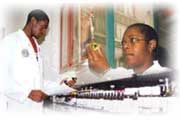![]()
Services
Updated: 11/22/04
Alcohol and Tobacco
Alcohol and tobacco products are analyzed in support of ATF's mission to prohibit diversion and trafficking of such products. Illegal alcohol and contraband cigarettes seized during investigations are examined to determine the product's authenticity or origin.
Arson
Fire debris collected at suspected arson crime scenes is examined to identify accelerants, incendiaries, and incendiary device components. Identification of an accelerant provides evidence that the crime of arson was committed.
Explosives
Evidence collected at explosive scenes is examined to identify the explosives used and to identify blasting caps, leg wires, fuses, timing mechanisms, energy sources, firing train, radio control components, igniters, containers, wire, tapes, and other component parts that may have been used to make the bomb.
Trace Evidence Comparisons
Microscopic, chemical, physical, and instrumental comparisons of a wide variety of physical evidence collected at crime scenes are performed. Such materials include tapes, wires, glass, metals, plastics, adhesives, hair, paint, fibers, and paper. These examinations are to identify materials that may associate a suspect with the crime.
Questioned Document Examination
Document examinations include the identification of handwriting, handprinting, mechanical impressions, such as typewriters, rubber stamps, etc., and counterfeit cigarette tax stamps; the detection of altered and forged documents; the restoration and/or decipherment of eradicated, obliterated and charred documents; and the determination and decipherment’s of indented writings.
Fingerprint Examination
Most evidence received in the forensic laboratory is examined for the presence of identifiable latent prints. Evidence examined includes documents, component parts of bombs and incendiary devices, and firearms. Techniques used include: dye staining, super glue fuming, chemical developers, laser, and traditional powder techniques.
Firearm and Toolmark Examination
Examiners perform projectile comparison (ballistics), serial number restoration, weapon operability, bullet trajectory determinations, crime scene reconstruction of shooting incidents, and distance and shot pattern determinations. Toolmark examinations generally relate to bombing and arson crimes, and include comparisons of fracture matches and impressions caused by cutting, drilling, gripping and prying tools.
Fire Research Laboratory
ATF has established a Fire Research Laboratory within Laboratory Services to provide forensic fire scene investigation case support on behalf of ATF Certified Fire Investigators (CFIs). The FRL also undertakes research, education and training for prosecutors and the fire investigation community at-large. The FRL's scientific and engineering staff conducts scientific research directed at the determination of fire origin and cause, fire growth and spread and other fire phenomena that validates fire scene indicators and improves fire evidence analysis. The laboratory facilities include:
![]() Four calorimetry hoods designed to allow a wide range of measurements
Four calorimetry hoods designed to allow a wide range of measurements
![]() Large test cells in which multiple room scenarios, vehicle burns and multi-level
structure burns can be conducted
Large test cells in which multiple room scenarios, vehicle burns and multi-level
structure burns can be conducted
![]() Small-scale test areas
Small-scale test areas
![]() Bench-scale
testing equipment
Bench-scale
testing equipment
![]() Laboratory space for electrical testing
Laboratory space for electrical testing
![]() Observation space for visitors and classroom/training space for up to
50 people
Observation space for visitors and classroom/training space for up to
50 people
The Fire Research Laboratory (FRL) will also provide training to CFIs and other state and local fire investigators, and will serve as a repository for fire related test data. The laboratory will provide a controlled environment where fire scientists, engineers and researchers can evaluate fire investigation theories and fire cause determination scenarios can be reconstructed and tested.
Automated Ballistic Identification
The laboratory supports ATF’s firearms enforcement programs. Electronic images of bullets and cartridge cases, recovered from crime scenes and suspect weapons are entered into a computer-based system, called IBIS, for searching and comparison against other bullets and cartridge cases. ATF and the Laboratory have been instrumental in the implementation of this exciting new technology in crime laboratories throughout the world.
National Response Team
ATF has four national response teams (NRT) that respond to major bombing and fire scenes nationally and internationally. An NRT consists of highly trained criminal investigators, forensic chemists, and explosive technology experts. The NRT responds to the scene within 24 hours. The evidence is collected and preliminary laboratory examination is completed before the team leaves the scene.
Training
Chemists and forensic examiners routinely provide instruction to ATF special agents, inspectors, auditors and other federal, state and local law enforcement personnel. Laboratory staff teaches at the Federal Law Enforcement Training Center in Glynco, GA and participates in both ATF-sponsored and industry-sponsored seminars as well as technical and scientific symposia across the country.
Research
Laboratory Services scientists develop new analytical methods and are recognized leaders in the analysis of alcohol and tobacco products and the examination of fire and explosion debris. The staff regularly contributes to leading scientific journals and professional societies on a national and international level.
Customer Service
Laboratory Services is committed to providing the best service and support to its customers. Our strategic plan, Lab-2002, outlines this commitment to meeting customer requirements; measuring performance and customer satisfaction; and seeking continuous improvement.

